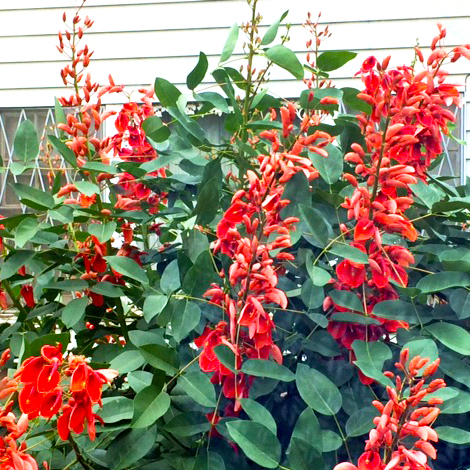Fireman’s cap – plant of intrigue
Fireman’s cap is a plant with international intrigue. It’s a result of a cross between a native southern United States species and one native to central South America. What’s interesting is that this cross was first performed by William MacArthur in the early 1840s at Camden Park in Australia.

MacArthur was one of the most active and influential horticulturists of his time in Australia. The English botanist John Carne Bidwell, then living in Sydney, sent a sample of the cross to England, suggesting the name Erythrina macarthuri to honor its originator. When the plant was entered into the botanical register in 1847, the origin of the plant was evidently not clear to the publisher, as he named it after Bidwell, hence the name of the cross that we use today.
Fireman’s cap is a woody, multi-stemmed shrub that grows 8 to 12 ft. tall and 10 to 15 ft. wide. The compound leaves consist of three triangle-shaped leaflets. It blooms continuously on the new growth from spring through fall with peak flowering in the summer months. The bright red, banana-shaped flowers, appear on 20-in. long terminal clusters that stand above and beyond the foliage on the long, arching stems of the shrub. Hummingbirds love the flowers.
Plant fireman’s cap in full sun. It is tolerant of most types of soil as long as it has excellent drainage. The shrub gets large, so give it plenty of room. It responds well to pruning and can be trained to climb a trellis.
It dies to the ground after a killing freeze but will return from its roots the following spring. Should it freeze, cut the frost-killed stems back in the fall or early spring. Mulch heavily in the northern half of the state to protect its roots. Fireman’s cap may be slow to begin growing in the spring until temperatures warm. This shrub thrives in hot weather.
Fireman’s cap fits very well into a cottage, southwestern-style, or pollinator garden. It also lends a tropical look to the landscape and looks nice with cannas and other tropical-looking plants around a pool or patio. Place it toward the back of a mixed border on account of its size.
What you’ll want to know…
Botanical name: Erythrina x bidwillii. The genus name comes from Greek erythros, meaning “red.”
Common names: Fireman’s cap, coral bean, coral tree, coral shrub tree.
Plant Family: Fabaceae, or pea family.
Hardiness Zones: 7b-10B. Cold-hardy to 20F with no damage to top growth. Root hardy to colder temperatures, especially when root system is mulched.
Pest problems: None of major importance.


